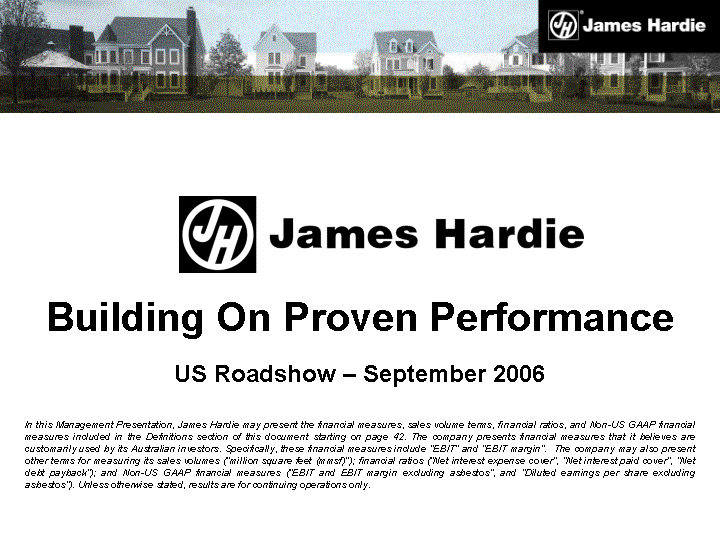

| Building On Proven Performance US Roadshow - September 2006 In this Management Presentation, James Hardie may present the financial measures, sales volume terms, financial ratios, and Non-US GAAP financial measures included in the Definitions section of this document starting on page 42. The company presents financial measures that it believes are customarily used by its Australian investors. Specifically, these financial measures include "EBIT" and "EBIT margin". The company may also present other terms for measuring its sales volumes ("million square feet (mmsf)"); financial ratios ("Net interest expense cover", "Net interest paid cover", "Net debt payback"); and Non-US GAAP financial measures ("EBIT and EBIT margin excluding asbestos", and "Diluted earnings per share excluding asbestos"). Unless otherwise stated, results are for continuing operations only. |
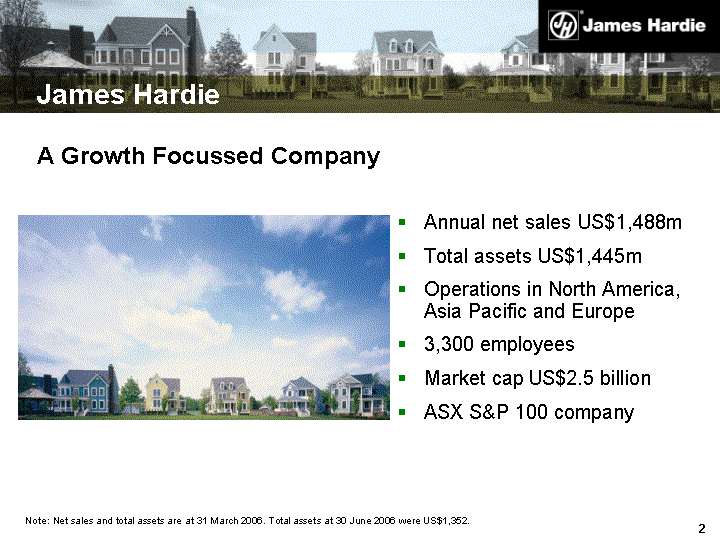
| James Hardie Annual net sales US$1,488m Total assets US$1,445m Operations in North America, Asia Pacific and Europe 3,300 employees Market cap US$2.5 billion ASX S&P 100 company Note: Net sales and total assets are at 31 March 2006. Total assets at 30 June 2006 were US$1,352. A Growth Focussed Company |
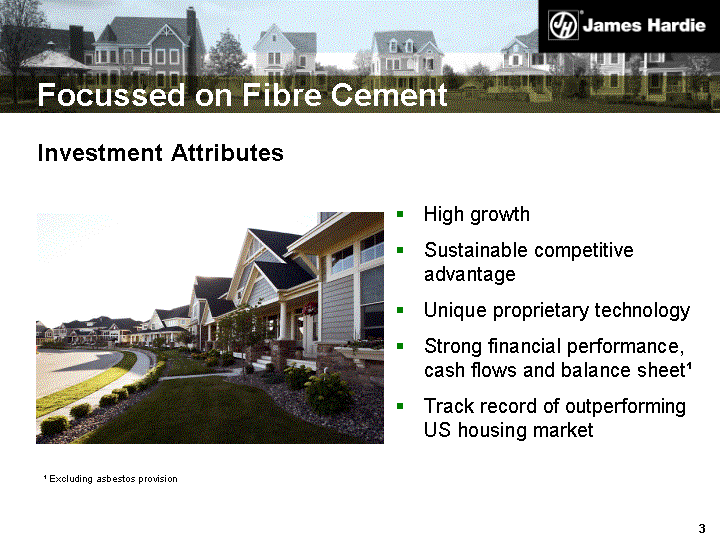
| Focussed on Fibre Cement High growth Sustainable competitive advantage Unique proprietary technology Strong financial performance, cash flows and balance sheet1 Track record of outperforming US housing market Investment Attributes Investment Attributes 1 Excluding asbestos provision |
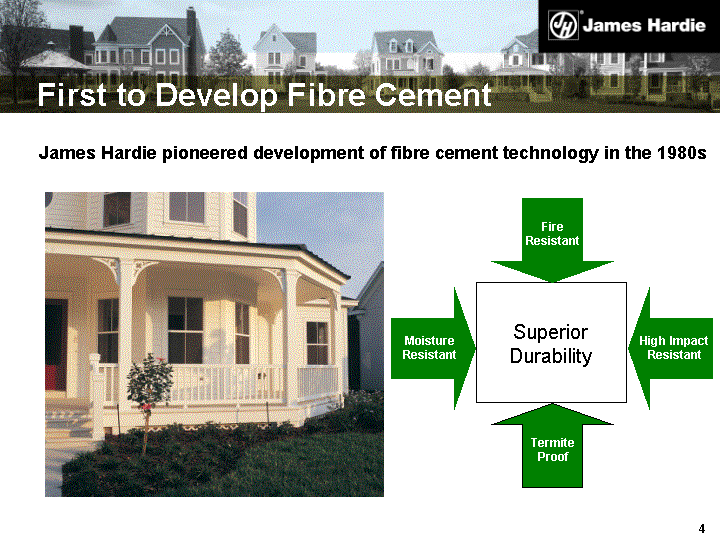
| First to Develop Fibre Cement James Hardie pioneered development of fibre cement technology in the 1980s James Hardie pioneered development of fibre cement technology in the 1980s Superior Durability Fire Resistant High Impact Resistant Moisture Resistant Termite Proof |
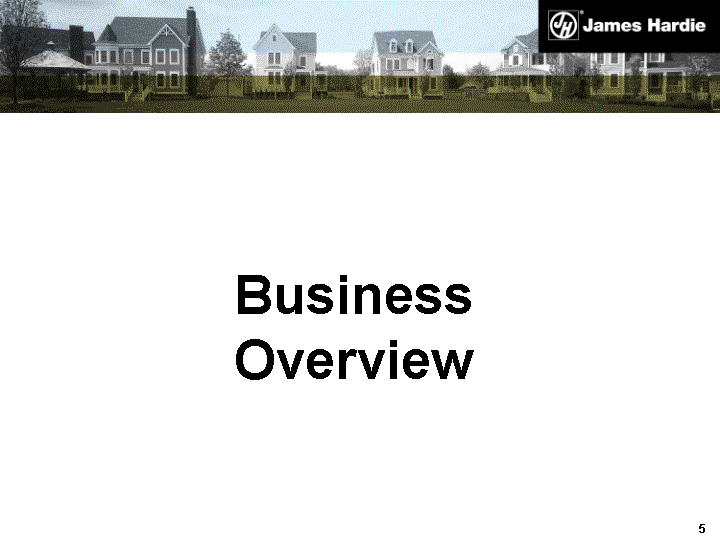
| Business Overview |
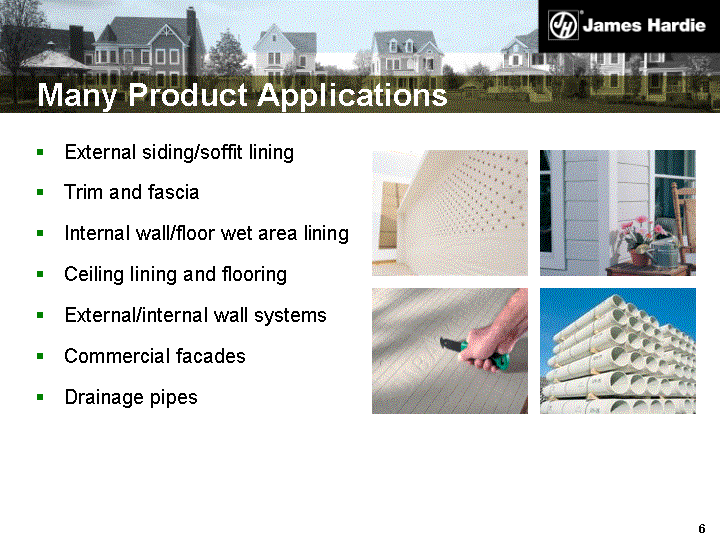
| Many Product Applications External siding/soffit lining Trim and fascia Internal wall/floor wet area lining Ceiling lining and flooring External/internal wall systems Commercial facades Drainage pipes |
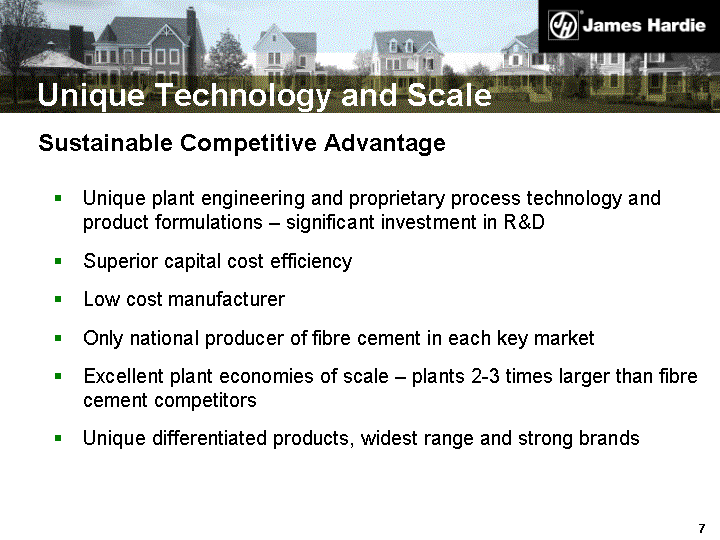
| Unique Technology and Scale Sustainable Competitive Advantage Unique plant engineering and proprietary process technology and product formulations - significant investment in R&D Superior capital cost efficiency Low cost manufacturer Only national producer of fibre cement in each key market Excellent plant economies of scale - plants 2-3 times larger than fibre cement competitors Unique differentiated products, widest range and strong brands |

| Focus Industry Leadership and Profitable Growth Aggressively grow the market Secure differentiated position Generate strong top line growth Win high shares of large segments Sustain attractive margins |
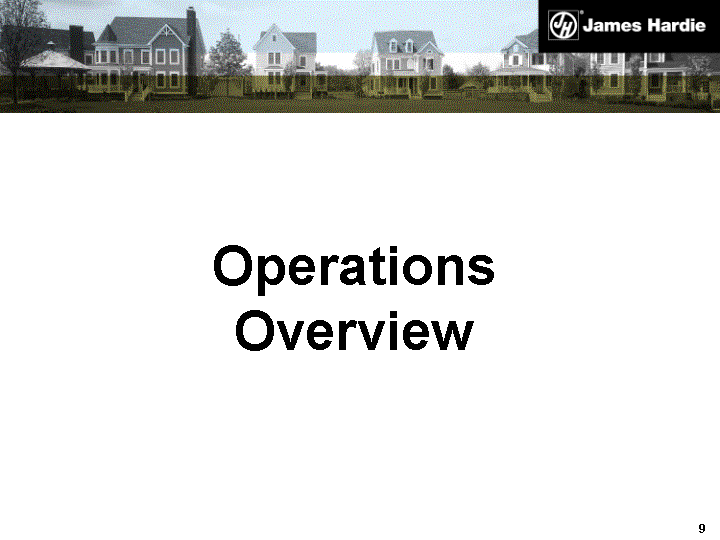
| Operations Overview |

| Business Portfolio FY 20061 Total Identifiable Assets*,# Sales EBIT2,# USA Fibre Cement Established high growth/high return 79% 82% 95% Asia Pacific Fibre Cement Established high return 16% 16% 12% Other Potential growth opportunities (Pipes, Europe) 5% 2% (7%)2 1 At and for the fiscal year ended 31 March 2006 * Excludes General Corporate # Excludes General Corporate, Research and Development and Asbestos Provision 2 Includes Roofing and Chile - both discontinued in FY06 |
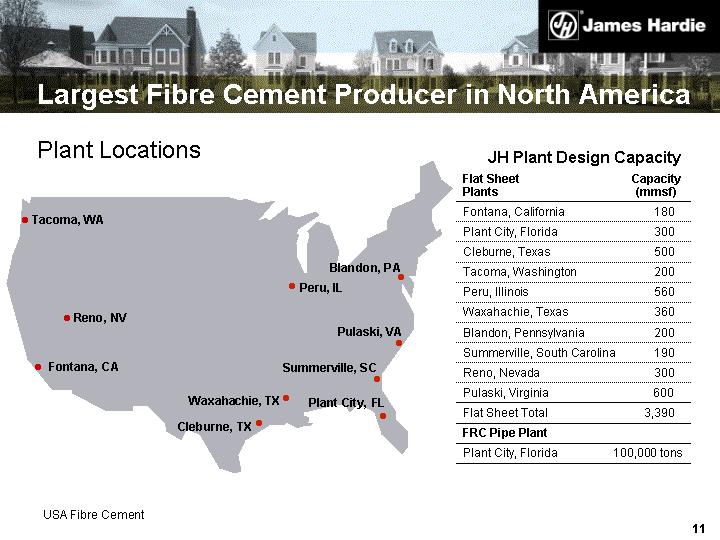
| Largest Fibre Cement Producer in North America Flat Sheet Plants Flat Sheet Plants Capacity (mmsf) Fontana, California Fontana, California 180 Plant City, Florida Plant City, Florida 300 Cleburne, Texas Cleburne, Texas 500 Tacoma, Washington Tacoma, Washington 200 Peru, Illinois Peru, Illinois 560 Waxahachie, Texas Waxahachie, Texas 360 Blandon, Pennsylvania Blandon, Pennsylvania 200 Summerville, South Carolina Summerville, South Carolina 190 Reno, Nevada Reno, Nevada 300 Pulaski, Virginia Pulaski, Virginia 600 Flat Sheet Total Flat Sheet Total 3,390 FRC Pipe Plant FRC Pipe Plant Plant City, Florida 100,000 tons 100,000 tons JH Plant Design Capacity Plant Locations USA Fibre Cement |
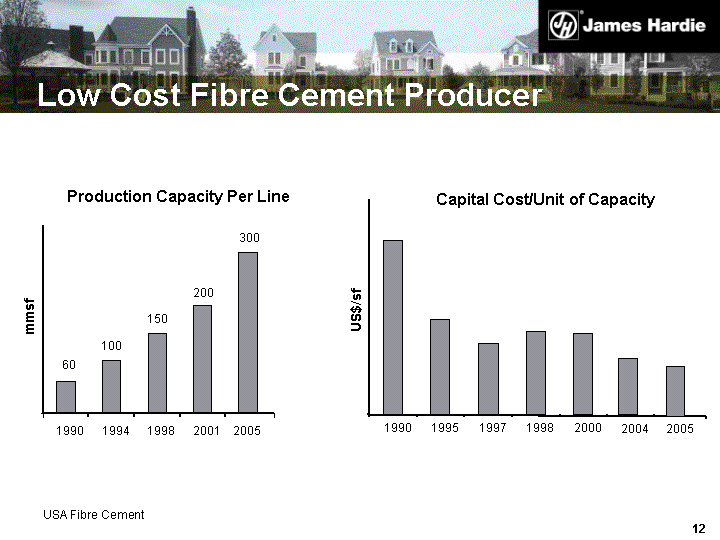
| Low Cost Fibre Cement Producer mmsf 1990 1994 1998 2001 2005 60 100 150 200 300 Production Capacity Per Line 1990 1995 1997 1998 2000 2004 US$/sf Capital Cost/Unit of Capacity 2005 USA Fibre Cement |

| Superior Product Performance Fibre Cement is more durable than wood and engineered wood Fibre Cement Superior Durability Moisture Resistant Fire Resistant Weather Resistant Termite Proof Resists Warping Resists Cracking Resists Rotting Holds Paint Longer ? ? ? ? ? ? ? ? ? ? ? ? ? ? ? ? Engineered Wood USA Fibre Cement |
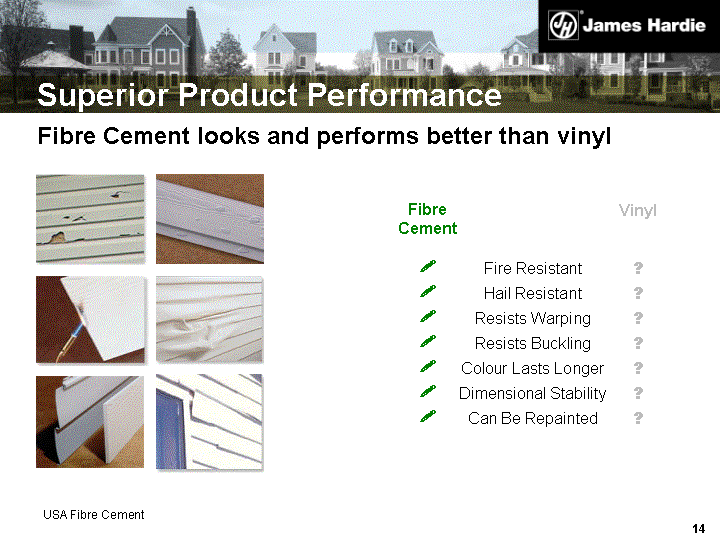
| Superior Product Performance Fibre Cement looks and performs better than vinyl Vinyl Fire Resistant Hail Resistant Resists Warping Resists Buckling Colour Lasts Longer Dimensional Stability Can Be Repainted ? ? ? ? ? ? ? ? ? ? ? ? ? ? Fibre Cement USA Fibre Cement |
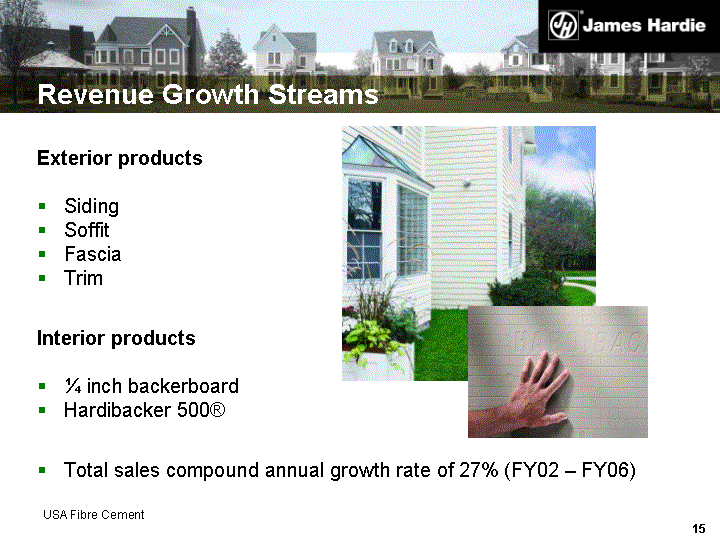
| Revenue Growth Streams Exterior products Siding Soffit Fascia Trim Interior products 1/4 inch backerboard Hardibacker 500(r) Total sales compound annual growth rate of 27% (FY02 - FY06) USA Fibre Cement |
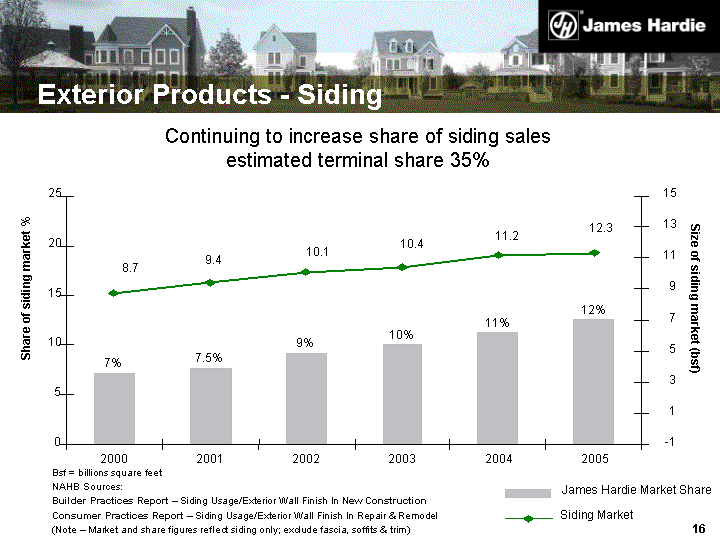
| Exterior Products - Siding Continuing to increase share of siding sales estimated terminal share 35% Bsf = billions square feet NAHB Sources: Builder Practices Report - Siding Usage/Exterior Wall Finish In New Construction Consumer Practices Report - Siding Usage/Exterior Wall Finish In Repair & Remodel (Note - Market and share figures reflect siding only; exclude fascia, soffits & trim) 7% 7.5% 9% 10% 11% 12% 8.7 9.4 10.1 10.4 11.2 12.3 0 5 10 15 20 25 2000 2001 2002 2003 2004 2005 Share of siding market % - -1 1 3 5 7 9 11 13 15 James Hardie Market Share Siding Market Size of siding market (bsf) |
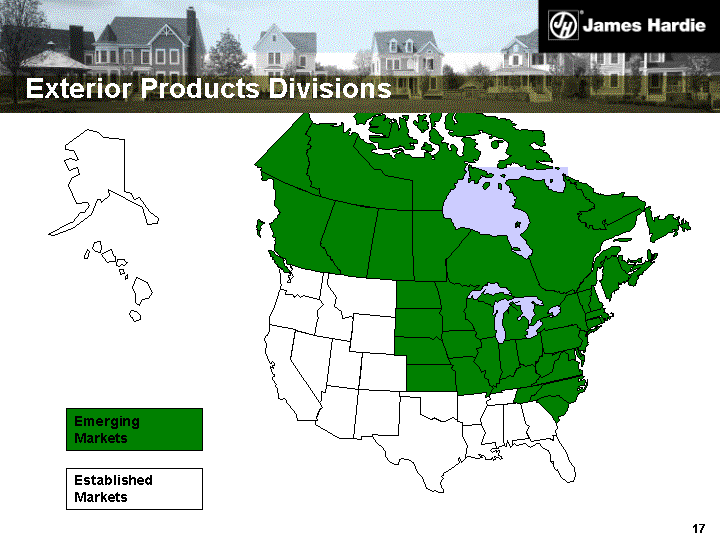
| VT Emerging Markets Established Markets Exterior Products Divisions |
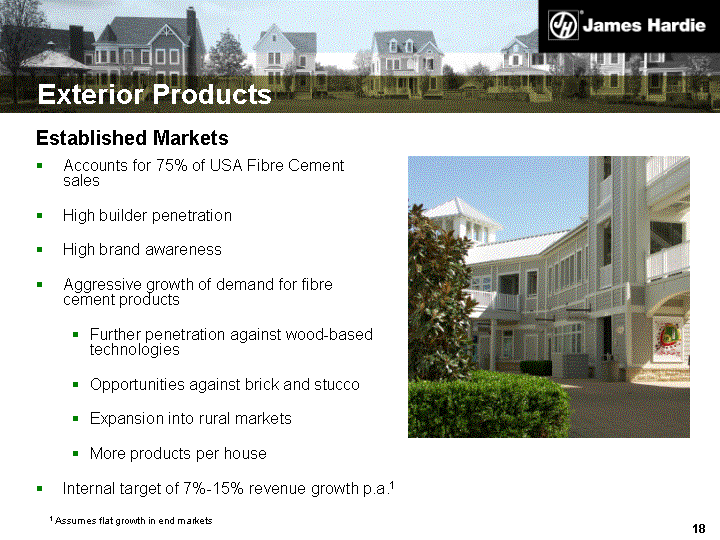
| Exterior Products Established Markets Accounts for 75% of USA Fibre Cement sales High builder penetration High brand awareness Aggressive growth of demand for fibre cement products Further penetration against wood-based technologies Opportunities against brick and stucco Expansion into rural markets More products per house Internal target of 7%-15% revenue growth p.a.1 1 Assumes flat growth in end markets |
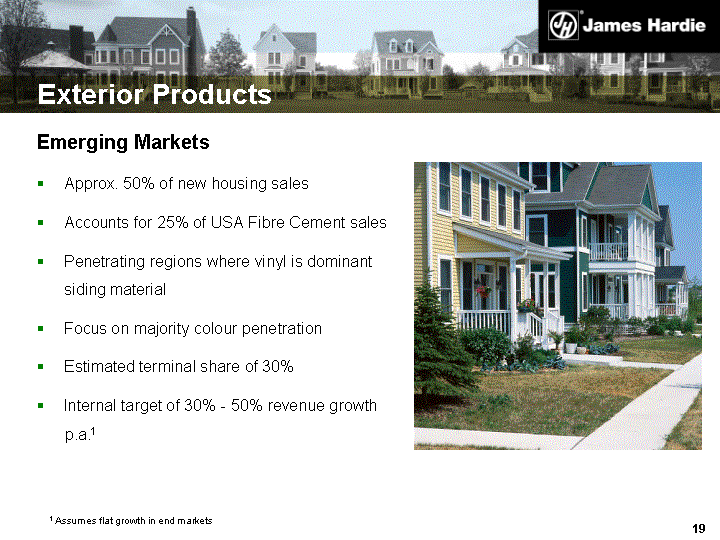
| Exterior Products Emerging Markets Approx. 50% of new housing sales Accounts for 25% of USA Fibre Cement sales Penetrating regions where vinyl is dominant siding material Focus on majority colour penetration Estimated terminal share of 30% Internal target of 30% - 50% revenue growth p.a.1 1 Assumes flat growth in end markets |
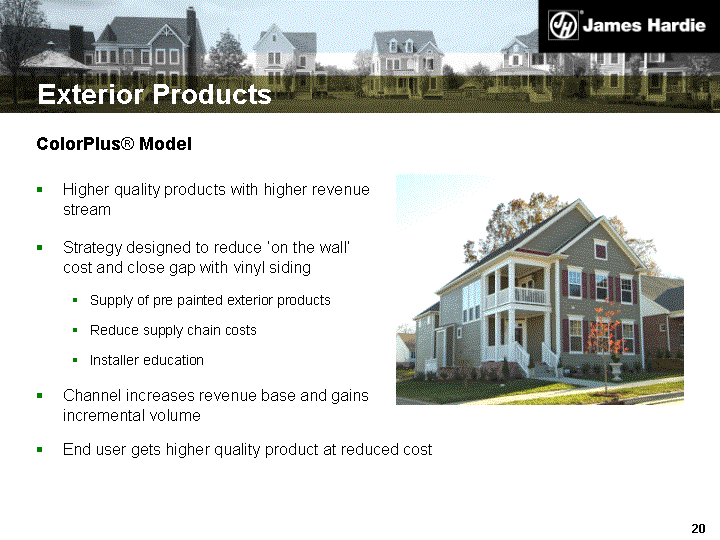
| Exterior Products ColorPlus(r) Model Higher quality products with higher revenue stream Strategy designed to reduce 'on the wall' cost and close gap with vinyl siding Supply of pre painted exterior products Reduce supply chain costs Installer education Channel increases revenue base and gains incremental volume End user gets higher quality product at reduced cost |
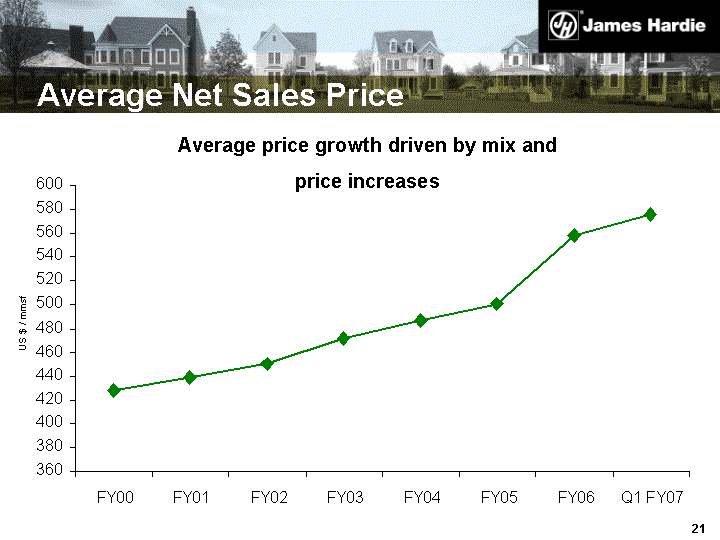
| Average Net Sales Price Average price growth driven by mix and price increases 360 380 400 420 440 460 480 500 520 540 560 580 600 FY00 FY01 FY02 FY03 FY04 FY05 FY06 Q1 FY07 US $ / mmsf |
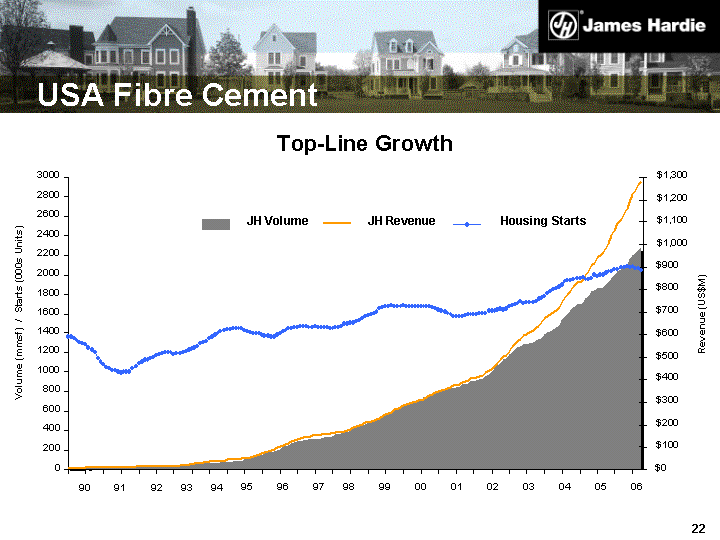
| USA Fibre Cement Top-Line Growth Top-Line Growth 0 200 400 600 800 1000 1200 1400 1600 1800 2000 2200 2400 2600 2800 3000 90 91 92 93 94 95 96 97 98 99 00 01 02 03 04 05 06 Volume (mmsf) / Starts (000s Units) $0 $100 $200 $300 $400 $500 $600 $700 $800 $900 $1,000 $1,100 $1,200 $1,300 Revenue (US$M) JH Volume JH Revenue Housing Starts |
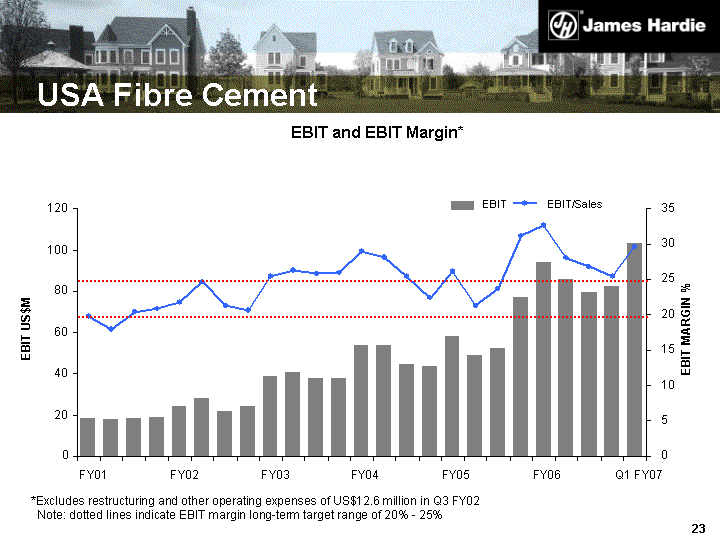
| USA Fibre Cement *Excludes restructuring and other operating expenses of US$12.6 million in Q3 FY02 Note: dotted lines indicate EBIT margin long-term target range of 20% - 25% EBIT and EBIT Margin* 0 20 40 60 80 100 120 FY01 FY02 FY03 FY04 FY05 FY06 Q1 FY07 EBIT US$M 0 5 10 15 20 25 30 35 EBIT MARGIN % EBIT EBIT/Sales |
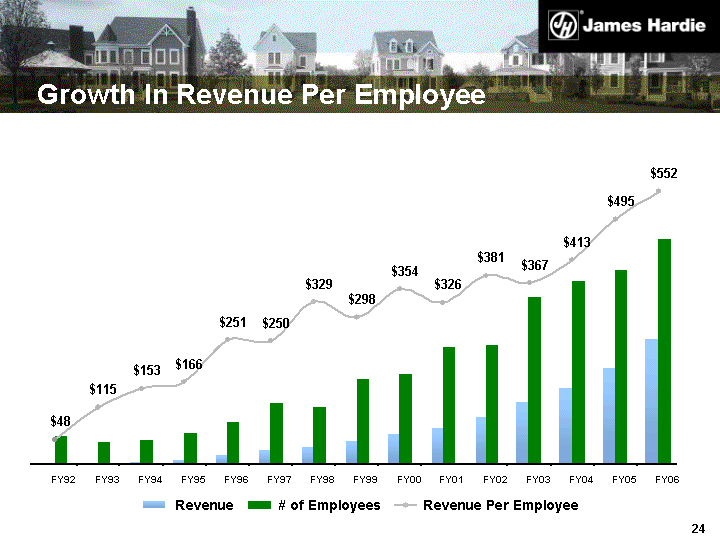
| Growth In Revenue Per Employee $552 $495 $48 $115 $153 $166 $251 $250 $329 $298 $354 $326 $381 $367 $413 FY92 FY93 FY94 FY95 FY96 FY97 FY98 FY99 FY00 FY01 FY02 FY03 FY04 FY05 FY06 Revenue # of Employees Revenue Per Employee |

| US New Housing Market - Slowing Key sales determinants Level of new housing construction activity Level of repair and remodelling activity Market development program effectiveness Price improvement New housing 70% of sales (repair and remodel 30%) Internal sales target of 15% - 25% p.a. growth (assumes flat market) South Central, South East, Pacific North West - largest sales regions Business considerations: Timing of capacity expansion, costs containment and efficiency improvements |
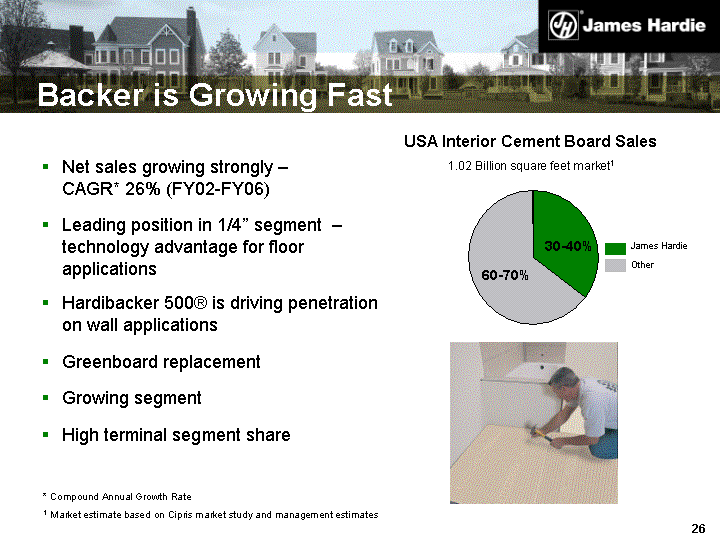
| Backer is Growing Fast Net sales growing strongly - CAGR* 26% (FY02-FY06) Leading position in 1/4" segment - technology advantage for floor applications Hardibacker 500(r) is driving penetration on wall applications Greenboard replacement Growing segment High terminal segment share * Compound Annual Growth Rate 1 Market estimate based on Cipris market study and management estimates USA Interior Cement Board Sales 1.02 Billion square feet market1 James Hardie Other 30-40% 60-70% |
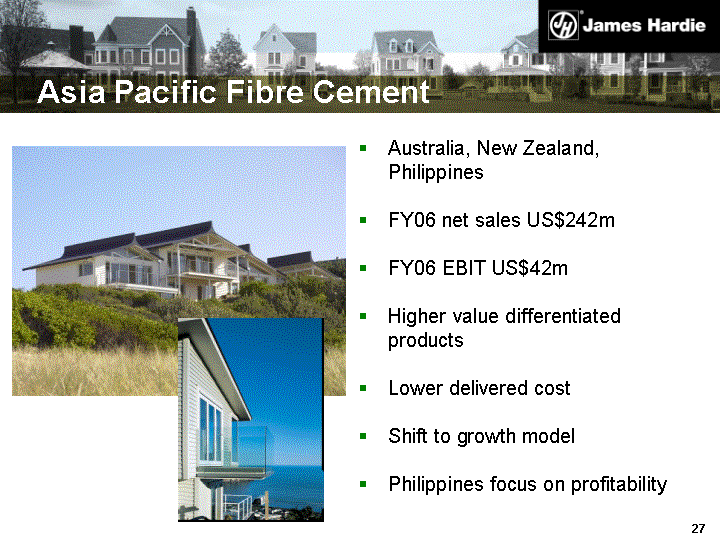
| Asia Pacific Fibre Cement Australia, New Zealand, Philippines FY06 net sales US$242m FY06 EBIT US$42m Higher value differentiated products Lower delivered cost Shift to growth model Philippines focus on profitability |
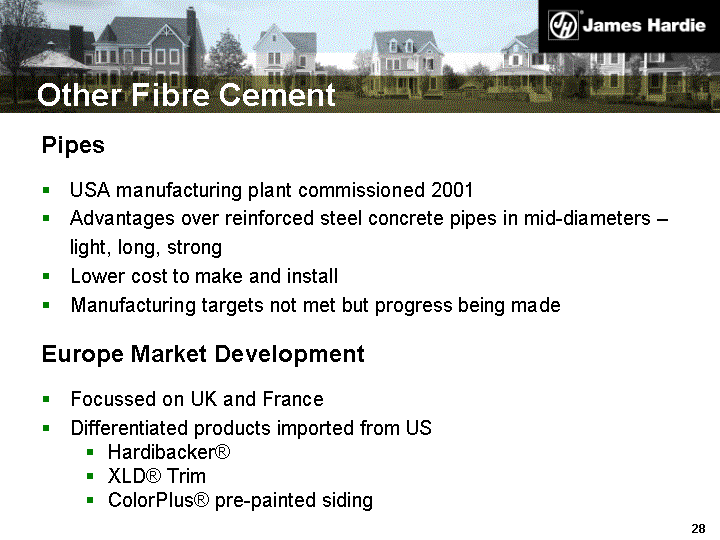
| Pipes USA manufacturing plant commissioned 2001 Advantages over reinforced steel concrete pipes in mid-diameters - light, long, strong Lower cost to make and install Manufacturing targets not met but progress being made Europe Market Development Focussed on UK and France Differentiated products imported from US Hardibacker(r) XLD(r) Trim ColorPlus(r) pre-painted siding Other Fibre Cement |

| Q1 FY07 Results |

| Results - Q1 FY07 US$Million Net Sales 415.5 Up 16% Gross Profit 157.7 Up 9% EBIT* 96.1 Up 11% Operating Profit* 62.7 Up 12% * Excludes effect of foreign exchange on asbestos provision. |
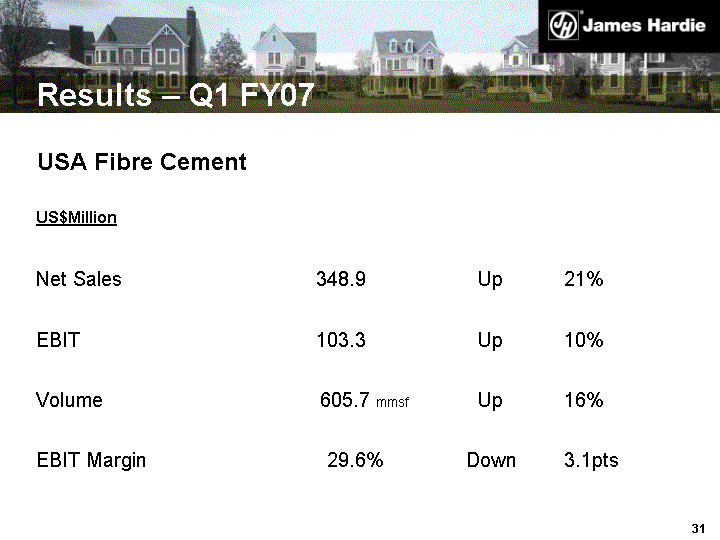
| Results - Q1 FY07 US$Million Net Sales 348.9 Up 21% EBIT 103.3 Up 10% Volume 605.7 mmsf Up 16% EBIT Margin 29.6% Down 3.1pts USA Fibre Cement |
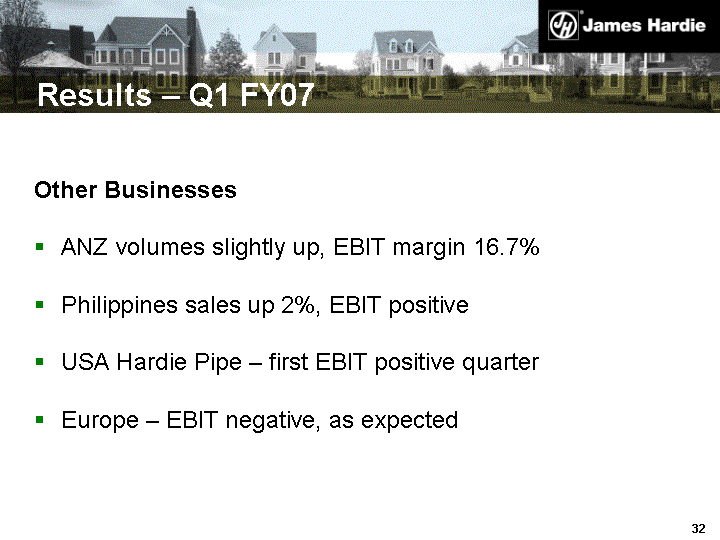
| Results - Q1 FY07 Other Businesses ANZ volumes slightly up, EBIT margin 16.7% Philippines sales up 2%, EBIT positive USA Hardie Pipe - first EBIT positive quarter Europe - EBIT negative, as expected |
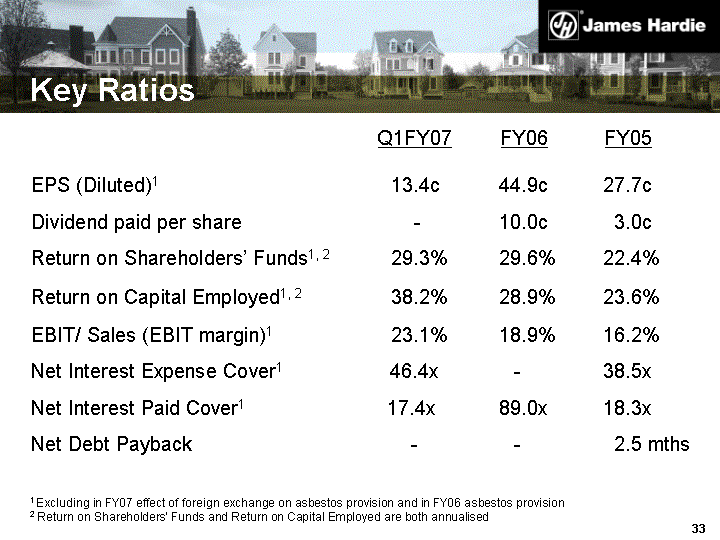
| Key Ratios Q1FY07 FY06 FY05 EPS (Diluted)1 13.4c 44.9c 27.7c Dividend paid per share - 10.0c 3.0c Return on Shareholders' Funds1, 2 29.3% 29.6% 22.4% Return on Capital Employed1, 2 38.2% 28.9% 23.6% EBIT/ Sales (EBIT margin)1 23.1% 18.9% 16.2% Net Interest Expense Cover1 46.4x - 38.5x Net Interest Paid Cover1 17.4x 89.0x 18.3x Net Debt Payback - - 2.5 mths 1 Excluding in FY07 effect of foreign exchange on asbestos provision and in FY06 asbestos provision 2 Return on Shareholders' Funds and Return on Capital Employed are both annualised |
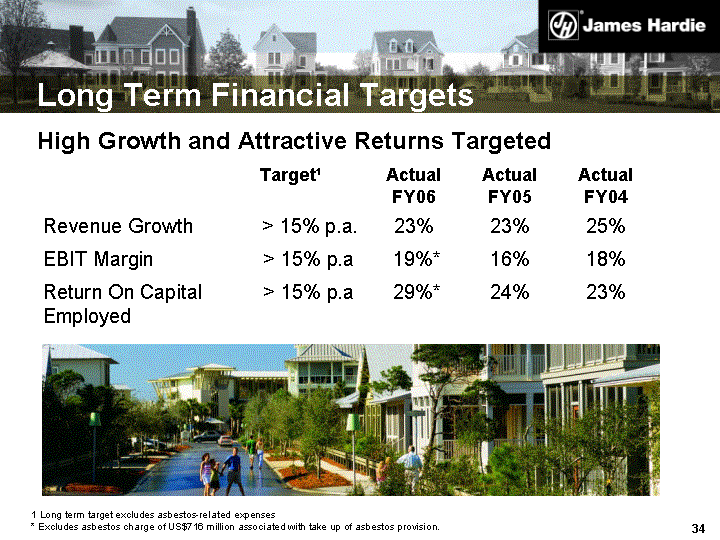
| High Growth and Attractive Returns Targeted Long Term Financial Targets Target1 Actual FY06 Actual FY05 Actual FY04 Revenue Growth > 15% p.a. 23% 23% 25% EBIT Margin > 15% p.a 19%* 16% 18% Return On Capital Employed > 15% p.a 29%* 24% 23% 1 Long term target excludes asbestos-related expenses * Excludes asbestos charge of US$716 million associated with take up of asbestos provision. |
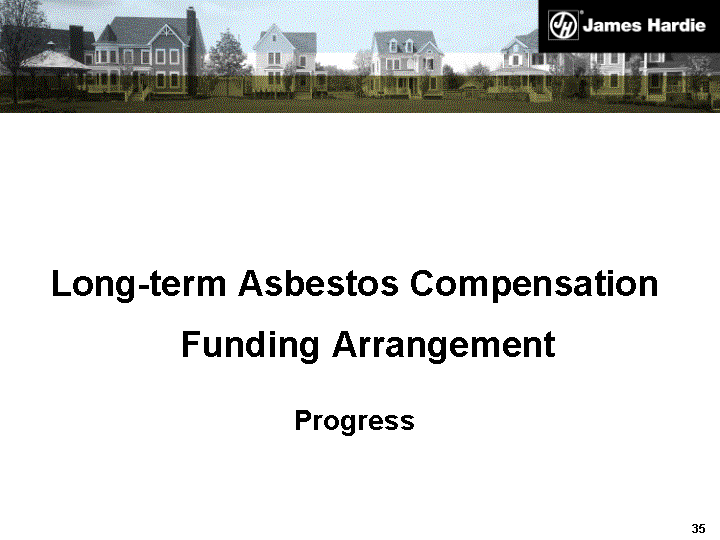
| Long-term Asbestos Compensation Funding Arrangement Progress |
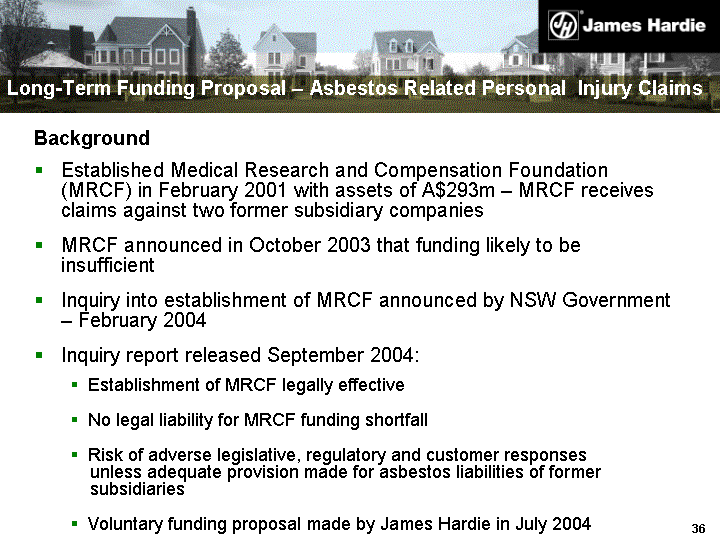
| Long-Term Funding Proposal - Asbestos Related Personal Injury Claims Background Established Medical Research and Compensation Foundation (MRCF) in February 2001 with assets of A$293m - MRCF receives claims against two former subsidiary companies MRCF announced in October 2003 that funding likely to be insufficient Inquiry into establishment of MRCF announced by NSW Government - - February 2004 Inquiry report released September 2004: Establishment of MRCF legally effective No legal liability for MRCF funding shortfall Risk of adverse legislative, regulatory and customer responses unless adequate provision made for asbestos liabilities of former subsidiaries Voluntary funding proposal made by James Hardie in July 2004 |

| Long-Term Funding Proposal - Asbestos Related Personal Injury Claims Non-binding agreement signed with NSW Government, union and claimants' representatives - December 2004 Funding arrangement intended to allow James Hardie to remain profitable, financially strong and to fund growth Final funding agreement signed with NSW Government - December 2005 (subject to conditions precedent) |

| Long-Term Funding Proposal - Asbestos Related Personal Injury Claims Key Elements Special Purpose Fund (SPF) to be established - James Hardie to appoint majority of Board Initial funding based on KPMG Actuaries updated report - discounted central estimate A$1.5bn at 31 March 2006 Annual contribution to SPF based on annual actuarial assessments A rolling 2 year cash buffer to be established in SPF Cap on annual contributions after 1st year based on a percentage of net operating cash flow - initial cap 35%, with phased reduction to 10% possible over time |

| Update Net provision of US$716m (A$1 billion) recorded at 31 March 2006 - "probable and estimable" under US GAAP Net provision adjusted to US$742m (A$1 billion) at 30 June 2006 due to FX (US$27m charge to P&L) June 2006, Australian Taxation Office (ATO) declined to endorse SPF as tax concession charity, but ruled annual contributions from James Hardie to SPF deductible over five years in accordance with "black hole" legislation for life of fund - both are conditions precedent to FFA Currently discussing potential and limited amendments to FFA with NSW Government Requires fresh binding rulings from ATO If satisfactory outcome, shareholder meeting to be held around 10 weeks from agreement being reached Lender and shareholder approval are also conditions precedent to the FFA |

| Voluntary Asbestos Compensation Funding Proposal Comparison Comparison A$ billions 30 Jun 04 31 Mar 05 30 Jun 05 31 Mar 06 Central Estimate - Discounted 1.536 1.685 1.5681 1.5171 Central Estimate - Undiscounted 3.586 3.604 3.1311 3.0791 Range - Undiscounted 2.0 - 5.7 2.0 - 5.9 1.5 - 5.51 1.7 - 5.31 Note: all amounts above are on a net present value basis 1 Includes estimated legal cost savings for NSW only |
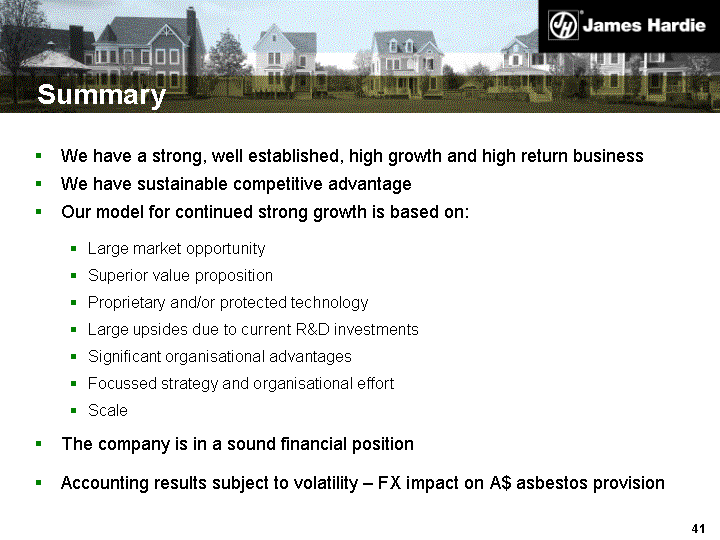
| Summary We have a strong, well established, high growth and high return business We have sustainable competitive advantage Our model for continued strong growth is based on: Large market opportunity Superior value proposition Proprietary and/or protected technology Large upsides due to current R&D investments Significant organisational advantages Focussed strategy and organisational effort Scale The company is in a sound financial position Accounting results subject to volatility - FX impact on A$ asbestos provision |
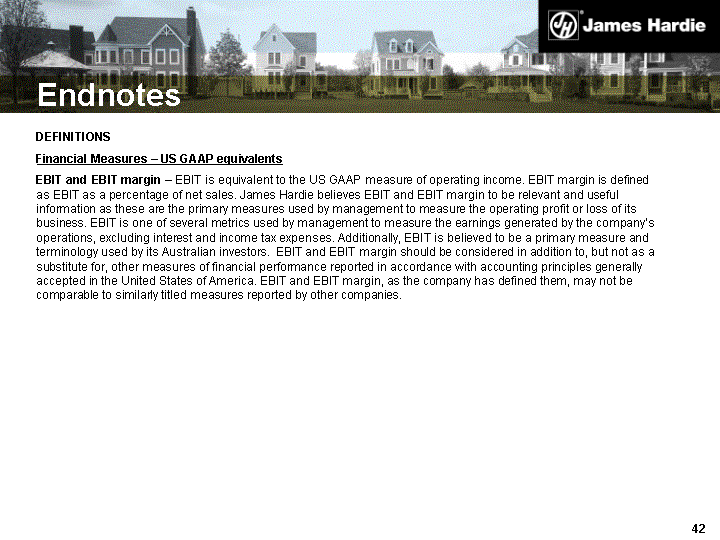
| Endnotes DEFINITIONS Financial Measures - US GAAP equivalents EBIT and EBIT margin - EBIT is equivalent to the US GAAP measure of operating income. EBIT margin is defined as EBIT as a percentage of net sales. James Hardie believes EBIT and EBIT margin to be relevant and useful information as these are the primary measures used by management to measure the operating profit or loss of its business. EBIT is one of several metrics used by management to measure the earnings generated by the company's operations, excluding interest and income tax expenses. Additionally, EBIT is believed to be a primary measure and terminology used by its Australian investors. EBIT and EBIT margin should be considered in addition to, but not as a substitute for, other measures of financial performance reported in accordance with accounting principles generally accepted in the United States of America. EBIT and EBIT margin, as the company has defined them, may not be comparable to similarly titled measures reported by other companies. |
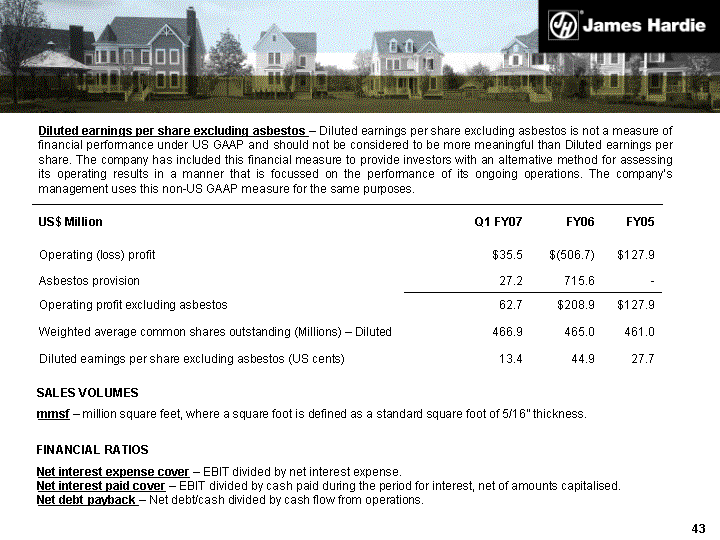
| Diluted earnings per share excluding asbestos - Diluted earnings per share excluding asbestos is not a measure of financial performance under US GAAP and should not be considered to be more meaningful than Diluted earnings per share. The company has included this financial measure to provide investors with an alternative method for assessing its operating results in a manner that is focussed on the performance of its ongoing operations. The company's management uses this non-US GAAP measure for the same purposes. US$ Million Q1 FY07 FY06 FY05 Operating (loss) profit $35.5 $(506.7) $127.9 Asbestos provision 27.2 715.6 - Operating profit excluding asbestos 62.7 $208.9 $127.9 Weighted average common shares outstanding (Millions) - Diluted 466.9 465.0 461.0 Diluted earnings per share excluding asbestos (US cents) 13.4 44.9 27.7 SALES VOLUMES mmsf - million square feet, where a square foot is defined as a standard square foot of 5/16" thickness. FINANCIAL RATIOS Net interest expense cover - EBIT divided by net interest expense. Net interest paid cover - EBIT divided by cash paid during the period for interest, net of amounts capitalised. Net debt payback - Net debt/cash divided by cash flow from operations. |
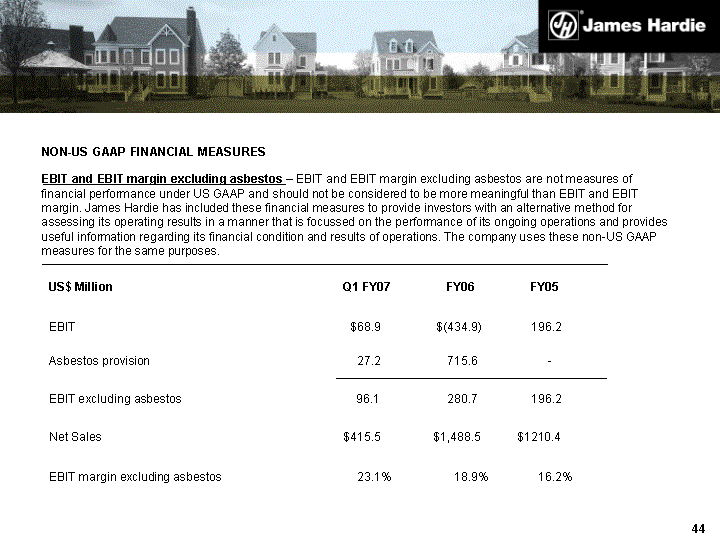
| NON-US GAAP FINANCIAL MEASURES EBIT and EBIT margin excluding asbestos - EBIT and EBIT margin excluding asbestos are not measures of financial performance under US GAAP and should not be considered to be more meaningful than EBIT and EBIT margin. James Hardie has included these financial measures to provide investors with an alternative method for assessing its operating results in a manner that is focussed on the performance of its ongoing operations and provides useful information regarding its financial condition and results of operations. The company uses these non-US GAAP measures for the same purposes. US$ Million Q1 FY07 FY06 FY05 EBIT $68.9 $(434.9) 196.2 Asbestos provision 27.2 715.6 - EBIT excluding asbestos 96.1 280.7 196.2 Net Sales $415.5 $1,488.5 $1210.4 EBIT margin excluding asbestos 23.1% 18.9% 16.2% |
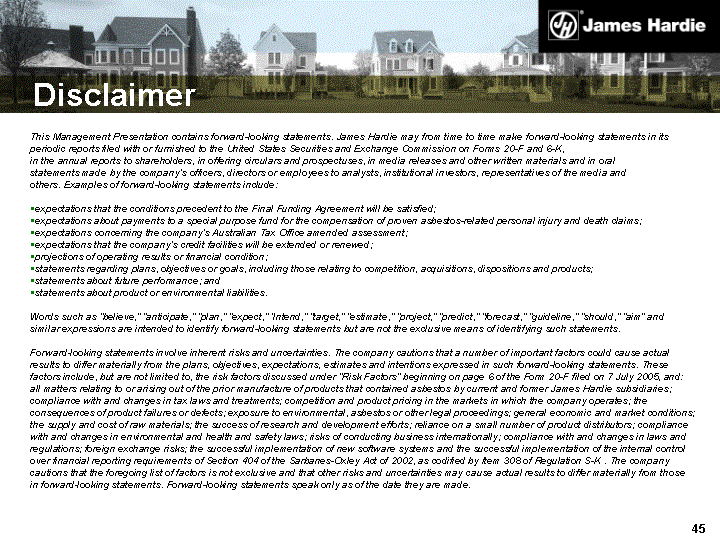
| Disclaimer This Management Presentation contains forward-looking statements. James Hardie may from time to time make forward-looking statements in its periodic reports filed with or furnished to the United States Securities and Exchange Commission on Forms 20-F and 6-K, in the annual reports to shareholders, in offering circulars and prospectuses, in media releases and other written materials and in oral statements made by the company's officers, directors or employees to analysts, institutional investors, representatives of the media and others. Examples of forward-looking statements include: expectations that the conditions precedent to the Final Funding Agreement will be satisfied; expectations about payments to a special purpose fund for the compensation of proven asbestos-related personal injury and death claims; expectations concerning the company's Australian Tax Office amended assessment; expectations that the company's credit facilities will be extended or renewed; projections of operating results or financial condition; statements regarding plans, objectives or goals, including those relating to competition, acquisitions, dispositions and products; statements about future performance; and statements about product or environmental liabilities. Words such as "believe," "anticipate," "plan," "expect," "intend," "target," "estimate," "project," "predict," "forecast," "guideline," "should," "aim" and similar expressions are intended to identify forward-looking statements but are not the exclusive means of identifying such statements. Forward-looking statements involve inherent risks and uncertainties. The company cautions that a number of important factors could cause actual results to differ materially from the plans, objectives, expectations, estimates and intentions expressed in such forward-looking statements. These factors include, but are not limited to, the risk factors discussed under "Risk Factors" beginning on page 6 of the Form 20-F filed on 7 July 2005, and: all matters relating to or arising out of the prior manufacture of products that contained asbestos by current and former James Hardie subsidiaries; compliance with and changes in tax laws and treatments; competition and product pricing in the markets in which the company operates; the consequences of product failures or defects; exposure to environmental, asbestos or other legal proceedings; general economic and market conditions; the supply and cost of raw materials; the success of research and development efforts; reliance on a small number of product distributors; compliance with and changes in environmental and health and safety laws; risks of conducting business internationally; compliance with and changes in laws and regulations; foreign exchange risks; the successful implementation of new software systems and the successful implementation of the internal control over financial reporting requirements of Section 404 of the Sarbanes-Oxley Act of 2002, as codified by Item 308 of Regulation S-K . The company cautions that the foregoing list of factors is not exclusive and that other risks and uncertainties may cause actual results to differ materially from those in forward-looking statements. Forward-looking statements speak only as of the date they are made. |